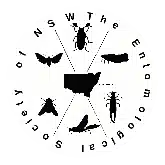Contents Vol. 39
GENERAL AND APPLIED ENTOMOLOGY
The Journal of the Entomological Society of New South Wales Inc.
VOLUME 39 CONTENTS
BATTA, Y., MURDOCH, G. and MANSFIELD, S. Investigations into the formulation and efficacy of entomopathogenic fungi against larvae of yellow mealworm (Tenebrio molitor L., Coleoptera: Tenebrionidae). ………… 5
A new invert emulsion formulation of entomopathogenic fungi was developed using non-toxic ingredients readily available in Australia and tested for compatibility with two Australian strains of Beauveria bassiana (Bals.). Laboratory bioassays were conducted to determine the efficacy of these fungi when applied in an invert emulsion formulation against yellow mealworm larvae, Tenebrio molitor L. The entomopathogenic fungi consistently caused higher mortality of T. molitor larvae when the invert emulsion was used compared with aqueous conidia suspensions. When B. bassiana strain BG1 was applied as an invert emulsion using different concentrations, the LC50 (measured as conidia mL-1) was > 600x lower than the LC50 of aqueous suspension of the conidia. The invert emulsion formulation tested improved the consistency and efficacy of the fungal strains tested against T. molitor under controlled conditions and has the potential to increase their efficacy when used on a commercial scale.
General and Applied Entomology 39: 5-8
CLARKE, A.R. and DOMINIAK, B.C. Positive correlation of male and female Bactrocera tryoni (Froggatt) (Diptera: Tephritidae) catches in orange-ammonia traps. …………. 9
Populations of the Queensland fruit fly, Bactrocera tryoni are routinely monitored using the male attractant cue-lure. This monitoring provides no information about female numbers. Using a data set of 1148 weekly clearances of orange-ammonia baited traps, which catch both males and females, the correlation between male and female numbers was tested for 48 weeks of the year (four weeks each month) and for the combined data set. Weekly male and female trap catches were significantly correlated for 47 of the 48 weeks, regardless of mean population size or time of year. For the whole 48 weeks, the correlation between male and female numbers was r = 0.722, significant at p < 0.001. Results suggest that changes in the numbers of male B. tryoni, as detected through cue-lure sampling, also reflects changes in number of females.
General and Applied Entomology 39: 9-13
REYNOLDS, O.L. and ORCHARD, B.A. Container loadings and eclosion units for sterile insect technique programs of Bactrocera tryoni (Froggatt) (Diptera: Tephritidae). ………….. 19
Management of Bactrocera tryoni (Froggatt) (Diptera: Tephritidae) may be achieved through the sterile insect technique (SIT). Plastic adult rearing containers (PARCs) are commonly used to rear and release sterile fruit flies; however these containers have not been optimised for B. tryoni. A laboratory study compared whether six different PARC loadings of pupae (180 g, 200 g, 230 g, 250 g, 280 g and 300 g) affected emergence and flight of sterile B. tryoni. Eclosion units utilised to rear the pupae to adults in the PARCs were compared in a laboratory study of emergence and flight and in a follow-on field study with respect to trap recapture rates of B. tryoni. Eclosion units tested included a i) wire grid, ii) mesh bag and iii) paper bags, and were compared with iv) no eclosion unit (control). PARC box loadings and eclosion units tested did not adversely affect emergence or flight of sterile B. tryoni. Trap recapture rates were the highest for control followed by the mesh bag. wire grid and paper bags. The value of these findings for utilising PARC’s to release sterile B. tryoni are discussed.
General and Applied Entomology 39: 19-22
STEVENS, M.M., MO, J. and GILLESPIE, P.S. Thrips (Thysanoptera) associated with rice crops in the Murrumbidgee irrigation area, New South Wales. ……………………. 15
Seventeen commercial rice crops in the northern section of the Murrumbidgee Irrigation Area in southern New South Wales were sampled for thrips in the 2001/2 and 2002/3 rice seasons to determine whether oriental rice thrips (Stenchaetothrips biformis (Bagnall)), which is established in southern Queensland, had spread to the New South Wales rice area. Twenty-one species of thrips were identified from 2220 specimens collected, however in each season four taxa, Thrips imaginis Bagnall, Anaphothrips obscurus (Muller), A. sudanensis Trybom and Haplothrips spp. together accounted for 84% or more of total collections. No other taxon exceeded 5% of captures in either season. Oriental rice thrips was not detected. There is no evidence to indicate that thrips communities found on rice during this survey were causing economic damage to the crop.
General and Applied Entomology 39: 15-18
STEVENS, M.M., STANTON, R.A., WU, H., SAMPSON, B., WEIR, T.A., REID, C.A.M. and MO, J. Detection of Lema bilineata Germar (Coleoptera: Chrysomelidae) in Australia. ……………………. 1
The South American chrysomelid Lema bilineata Germar is recorded for the first time in Australia. Adults and larvae were found feeding on Prairie Ground Cherry (Physalis viscosa L.) in an open greenhouse in Wagga Wagga in southern New South Wales during November 2008. The greenhouse population was eradicated immediately after it was recognised as a potential biosecurity threat but further detections of L. bilineata were subsequently made in the Cootamundra area. L. bilineata feeds on a range of solanaceous plants including both crop species and weeds, and has potential negative and positive impacts on agriculture in south-eastern Australia.
General and Applied Entomology 39: 1-3
VALENZUELA, I., BOULTON, A. and MALIPATIL, M.B. First record of Takecallis arundinariae (Essig) (Hemiptera: Aphididae) from Australia. ……… 23
Records are presented of the aphid Takecallis arundinariae (Essig) from Victoria and New South Wales on bamboo hosts. These are the first records of Takecallis in Australia.
General and Applied Entomology 39: 23-25
BOOK REVIEW:
The Complete Field Guide to Stick and Leaf Insects of Australia. ………….. 27
